Abstract
Effects of diethylstilbestrol (DES) on ion fluxes in oat roots (Avena sativa L.) were investigated by measuring K+ and Cl− absorption and K+ efflux. DES rapidly decreased the absorption of K+ (86Rb) and 36Cl− by excised roots; 10−4 molar DES inhibited Cl− absorption in 1 minute and K+ absorption in 1 to 2 minutes. With a 10-minute incubation period, K+ and Cl− absorption were inhibited 50% by 1.1×10−5 molar and 8.4×10−6 molar DES, respectively. Treatment for 3 minutes with 10−4 molar DES caused irreversible inhibition of K+ absorption. Increasing concentrations of KCl in the absorption media decreased the DES inhibition. Experiments with the DES analogs, DES dipropionate, dienestrol and hexestrol, showed that the steric configuration and the hydroxyl group of the DES molecule are important in determining the inhibitory capacity of the compound.
DES increased the efflux of 86Rb from excised roots only after a 10-minute lag period. In 10−4 molar DES, roots lost 82% of their radionuclide content in 1 hour. Comparison of efflux curves for roots loaded for 20 hours and those loaded for 15 minutes suggested that DES increased the permeability of the plasma membrane after about 10 minutes and the permeability of the tonoplast after 10 to 20 minutes. Oligomycin and dinitrophenol also increased the loss of 86Rb, but the lag period was about 4 hours.
The rapid effect of DES on ion absorption and the slower effect on ion efflux suggest that DES initially inhibits ion uptake by affecting the transport mechanism at the plasma membrane in some manner other than alteration of membrane permeability.
Full text
PDF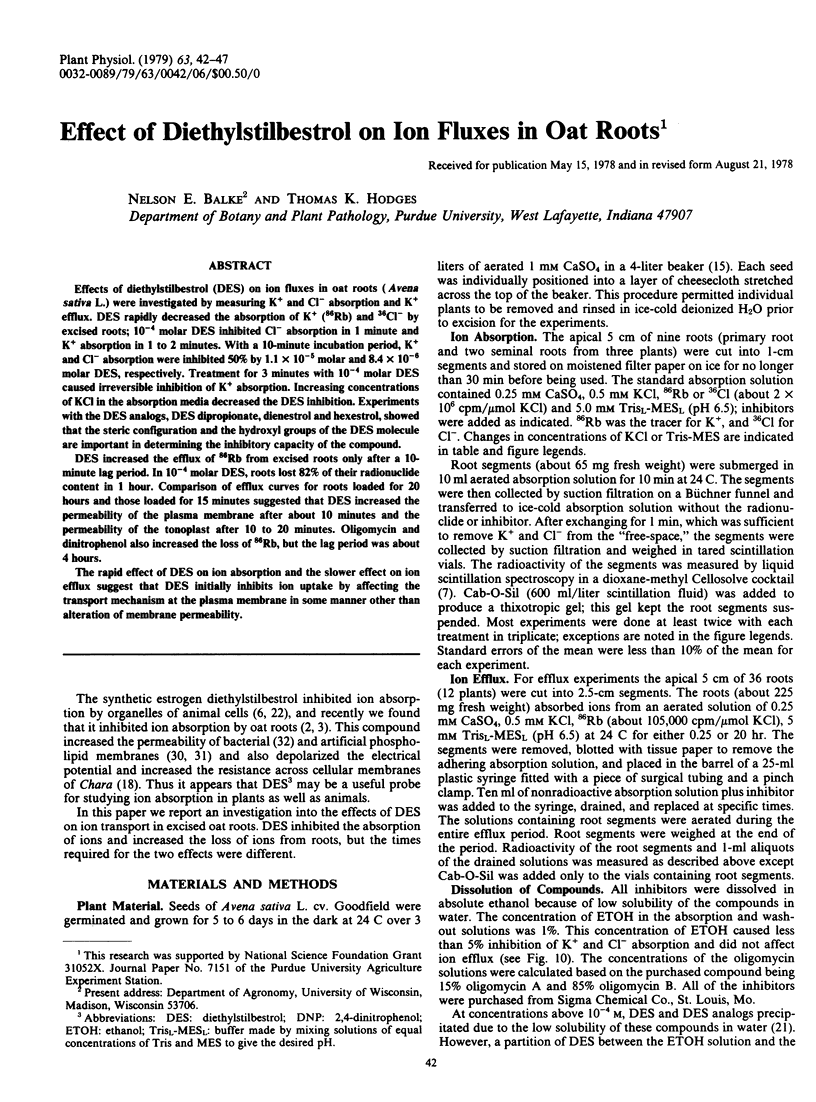
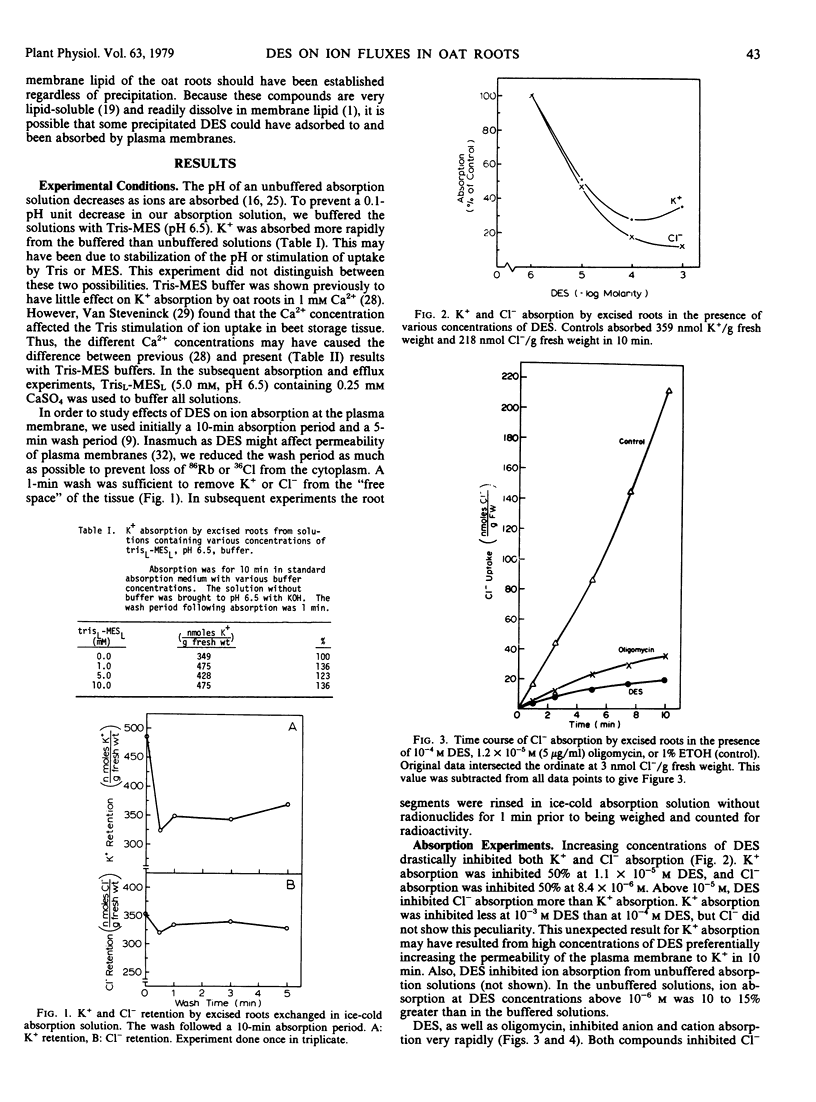

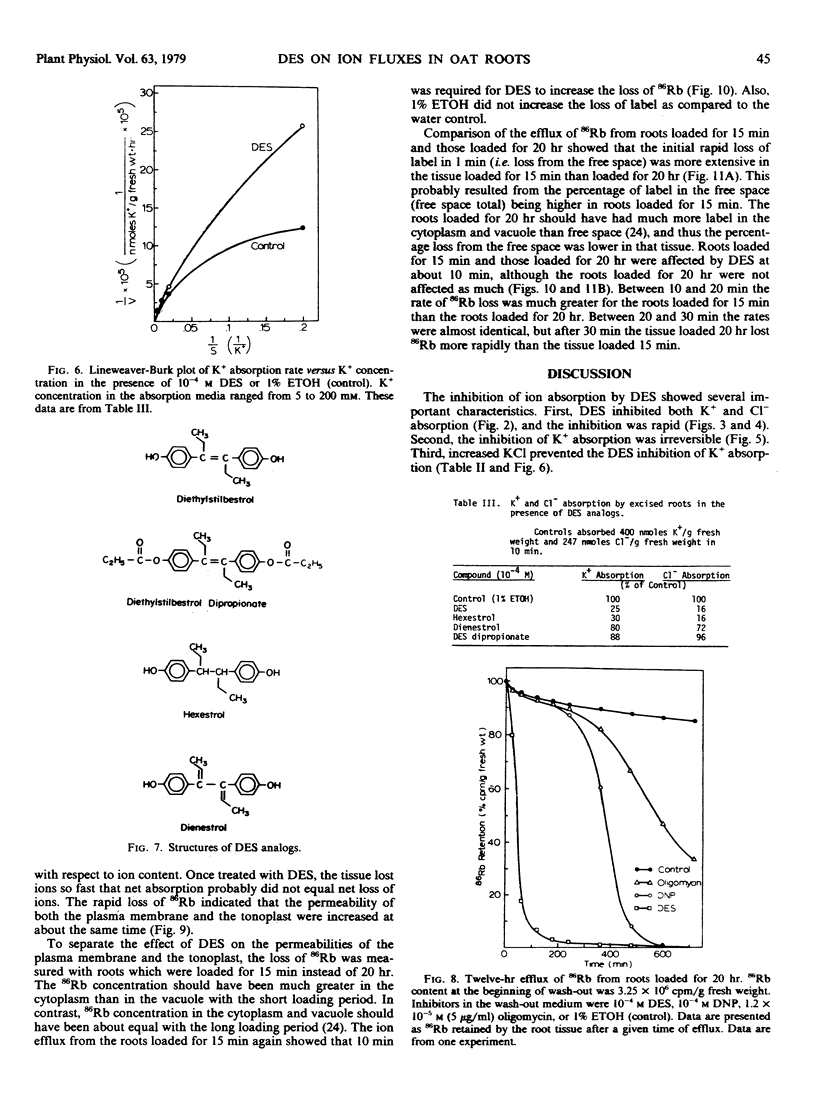
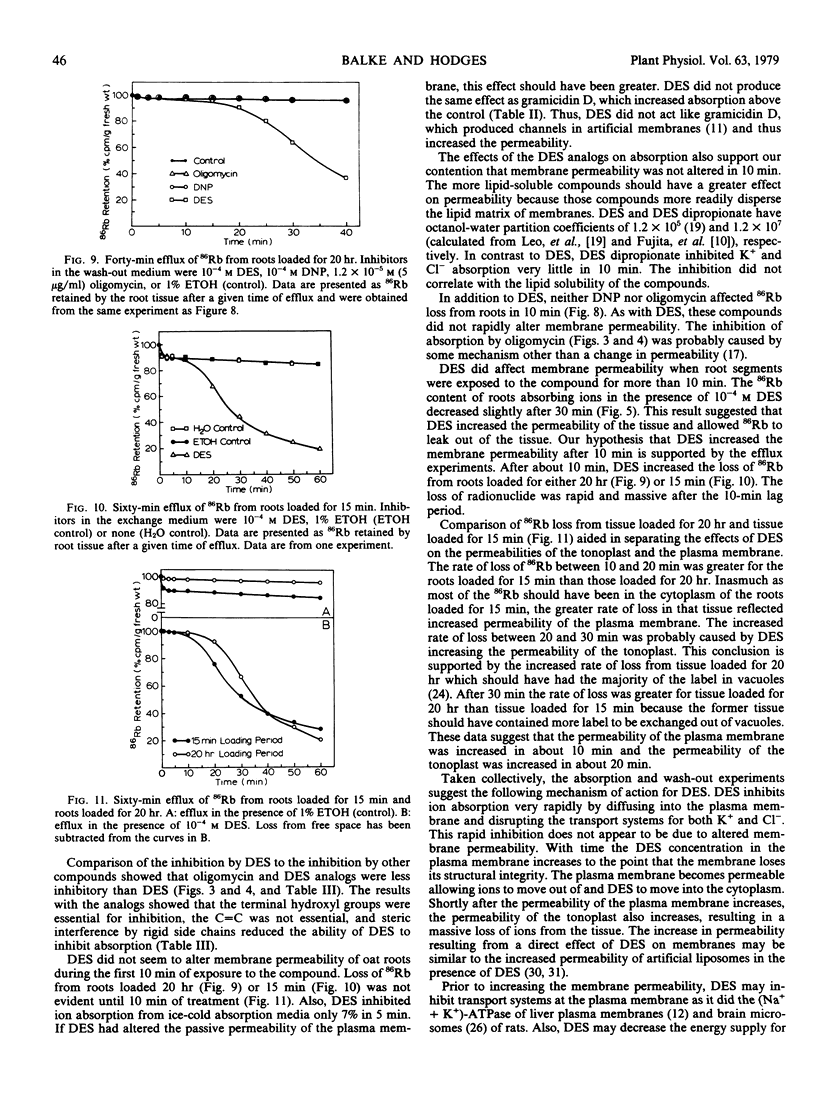
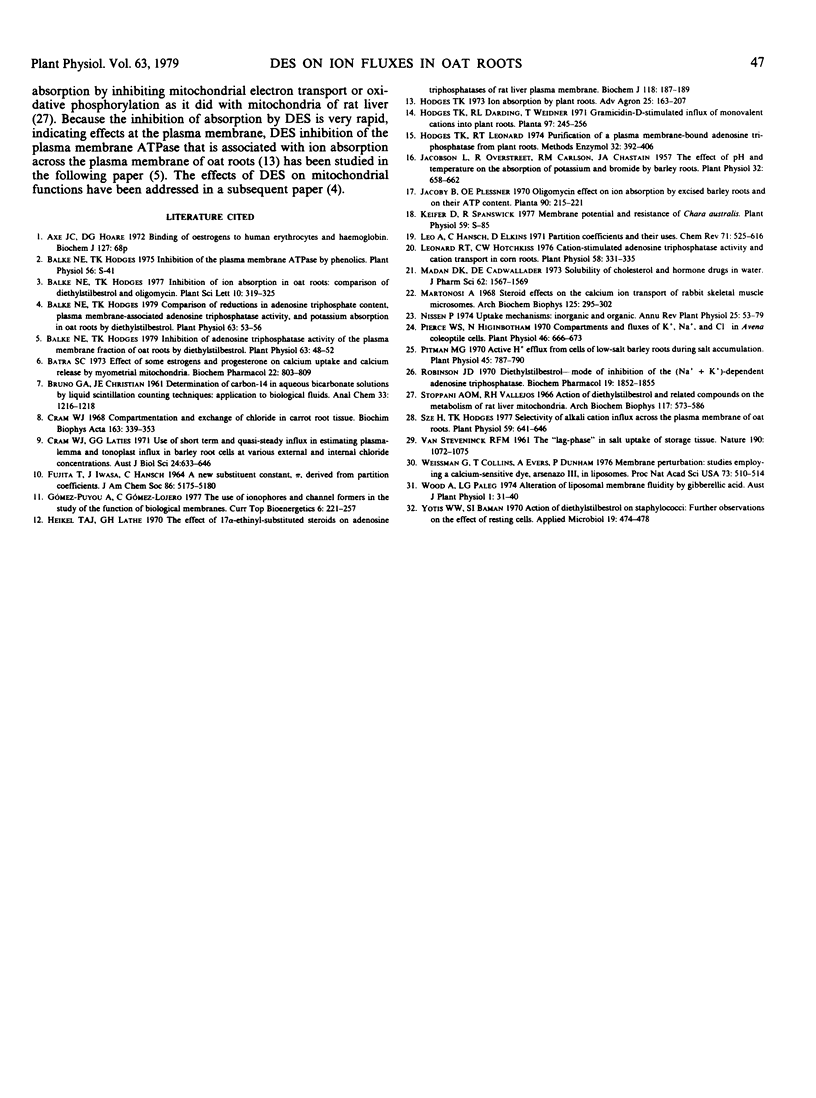
Selected References
These references are in PubMed. This may not be the complete list of references from this article.
- Balke N. E., Hodges T. K. Comparison of Reductions in Adenosine Triphosphate Content, Plasma Membrane-associated Adenosine Triphosphatase Activity, and Potassium Absorption in Oat Roots by Diethylstilbestrol. Plant Physiol. 1979 Jan;63(1):53–56. doi: 10.1104/pp.63.1.53. [DOI] [PMC free article] [PubMed] [Google Scholar]
- Balke N. E., Hodges T. K. Inhibition of adenosine triphosphatase activity of the plasma membrane fraction of oat roots by diethylstilbestrol. Plant Physiol. 1979 Jan;63(1):48–52. doi: 10.1104/pp.63.1.48. [DOI] [PMC free article] [PubMed] [Google Scholar]
- Batra S. C. Effect of some estrogens and progesterone on calcium uptake and calcium release by myometrial mitochondria. Biochem Pharmacol. 1973 Apr 1;22(7):803–809. doi: 10.1016/0006-2952(73)90359-6. [DOI] [PubMed] [Google Scholar]
- Cram W. J. Compartmentation and exchange of chloride in carrot root tissue. Biochim Biophys Acta. 1968 Nov 5;163(3):339–353. doi: 10.1016/0005-2736(68)90119-3. [DOI] [PubMed] [Google Scholar]
- Heikel T. A., Lathe G. H. The effect of 17-alpha-ethinyl-substituted steroids on adenosine triphosphatases of rat liver plasma membrane. Biochem J. 1970 Jun;118(1):187–189. doi: 10.1042/bj1180187. [DOI] [PMC free article] [PubMed] [Google Scholar]
- Hodges T. K., Leonard R. T. Purification of a plasma membrane-bound adenosine triphosphatase from plant roots. Methods Enzymol. 1974;32:392–406. doi: 10.1016/0076-6879(74)32039-3. [DOI] [PubMed] [Google Scholar]
- Jacobson L., Overstreet R., Carlson R. M., Chastain J. A. The Effect of pH and Temperature on the Absorption Of Potassium and Bromide by Barley Roots. Plant Physiol. 1957 Nov;32(6):658–662. doi: 10.1104/pp.32.6.658. [DOI] [PMC free article] [PubMed] [Google Scholar]
- Leonard R. T., Hotchkiss C. W. Cation-stimulated Adenosine Triphosphatase Activity and Cation Transport in Corn Roots. Plant Physiol. 1976 Sep;58(3):331–335. doi: 10.1104/pp.58.3.331. [DOI] [PMC free article] [PubMed] [Google Scholar]
- Madan D. K., Cadwallader D. E. Solubility of cholesterol and hormone drugs in water. J Pharm Sci. 1973 Sep;62(9):1567–1569. doi: 10.1002/jps.2600620947. [DOI] [PubMed] [Google Scholar]
- Martonosi A. Steroid effects on the calcium ion transport of rabbit skeletal muscle microsomes. Arch Biochem Biophys. 1968 Apr;125(1):295–302. doi: 10.1016/0003-9861(68)90664-4. [DOI] [PubMed] [Google Scholar]
- Pierce W. S., Higinbotham N. Compartments and Fluxes of K, NA, and CL in Avena Coleoptile Cells. Plant Physiol. 1970 Nov;46(5):666–673. doi: 10.1104/pp.46.5.666. [DOI] [PMC free article] [PubMed] [Google Scholar]
- Pitman M. G. Active H Efflux from Cells of Low-salt Barley Roots during Salt Accumulation. Plant Physiol. 1970 Jun;45(6):787–790. doi: 10.1104/pp.45.6.787. [DOI] [PMC free article] [PubMed] [Google Scholar]
- Robinson J. D. Diethyl stilbestrol--mode of inhibition of the (Na + +K + )-dependent adenosine triphosphatase. Biochem Pharmacol. 1970 May;19(5):1852–1855. doi: 10.1016/0006-2952(70)90186-3. [DOI] [PubMed] [Google Scholar]
- Sze H., Hodges T. K. Selectivity of alkali cation influx across the plasma membrane of oat roots: cation specificity of the plasma membrane ATPase. Plant Physiol. 1977 Apr;59(4):641–646. doi: 10.1104/pp.59.4.641. [DOI] [PMC free article] [PubMed] [Google Scholar]
- Weissmann G., Collins T., Evers A., Dunham P. Membrane perturbation: studies employing a calcium-sensitive dye, arsenazo III, in liposomes. Proc Natl Acad Sci U S A. 1976 Feb;73(2):510–514. doi: 10.1073/pnas.73.2.510. [DOI] [PMC free article] [PubMed] [Google Scholar]
- Yotis W. W., Baman S. I. Action of diethylstilbestrol on staphylococci: further observations on the effect of resting cells. Appl Microbiol. 1970 Mar;19(3):474–478. doi: 10.1128/am.19.3.474-478.1970. [DOI] [PMC free article] [PubMed] [Google Scholar]


